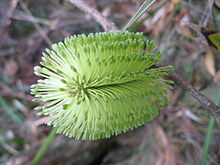Banksia integrifolia subsp. monticola
| White Mountain banksia | |
|---|---|

| |
| Inflorescence of Banksia integrifolia subsp. monticola in late bud | |
| Scientific classification | |
| Kingdom: | Plantae |
| Clade: | Tracheophytes |
| Clade: | Angiosperms |
| Clade: | Eudicots |
| Order: | Proteales |
| Family: | Proteaceae |
| Genus: | Banksia |
| Species: | |
| Subspecies: | B. i. subsp. monticola
|
| Trinomial name | |
| Banksia integrifolia subsp. monticola | |
Banksia integrifolia subsp. monticola, commonly known as White Mountain banksia, is a
Description
B. integrifolia subsp. monticola is similar to B. integrifolia subsp. integrifolia, but differs in having longer, narrower leaves, and follicles that are more deeply embedded in the old flower spike. Follicles are less likely to open spontaneously. Inflorescences are similar to those of subspecies integrifolia, but may be pink-tinged in some localities, notably in Barrington Tops National Park.[1] This subspecies contains the largest recorded Banksia specimens, with trees in Washpool National Park growing to 35 metres (110 feet) high.[2] It is the most frost tolerant banksia tree of all.
Taxonomy
For many years this subspecies was considered a mountain form of
Distribution and habitat
Unlike the other B. integrifolia subspecies, B. integrifolia subsp. monticola occurs well inland, in the
Cultivation and uses
It is valued because of its frost hardiness. It has been planted in England.
Gallery
-
Banksia integrifolia subsp. monticola habitat on Waterfall Way near the New England National Park turnoff
-
leaves on young plant
-
mature leaves
-
flower spike before anthesis
-
top end of flower spike
-
flowers after anthesis
References
- ^ ISBN 978-0-643-06454-6.
- ^ Liber C (2004). "Really Big Banksias". Banksia Study Group Newsletter. 6: 4–5.
- ^ .
- doi:10.1071/SB01013.
- ^ "Banksia integrifolia subsp. monticola K.R.Thiele". Australian Plant Name Index (APNI), IBIS database. Centre for Plant Biodiversity Research, Australian Government.
- ^ Brown, Roland Wilbur (1956). The Composition of Scientific Words. Washington, D.C.: Smithsonian Institution Press. p. 478.
External links
- "Banksia integrifolia subsp. monticola". Flora of Australia Online. Department of the Environment and Heritage, Australian Government.






